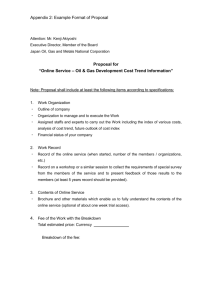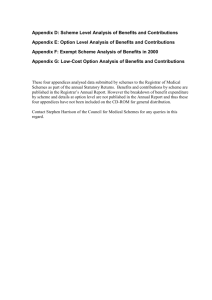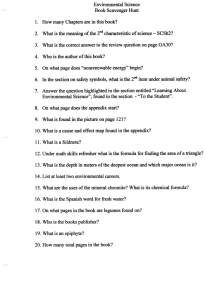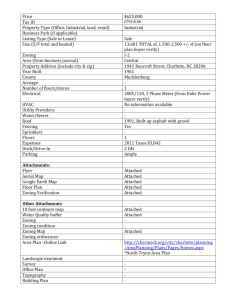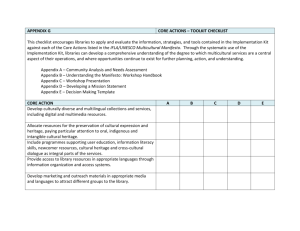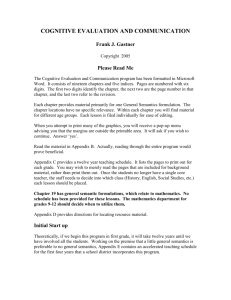The Importance of Citizen Participation in a Democracy
advertisement
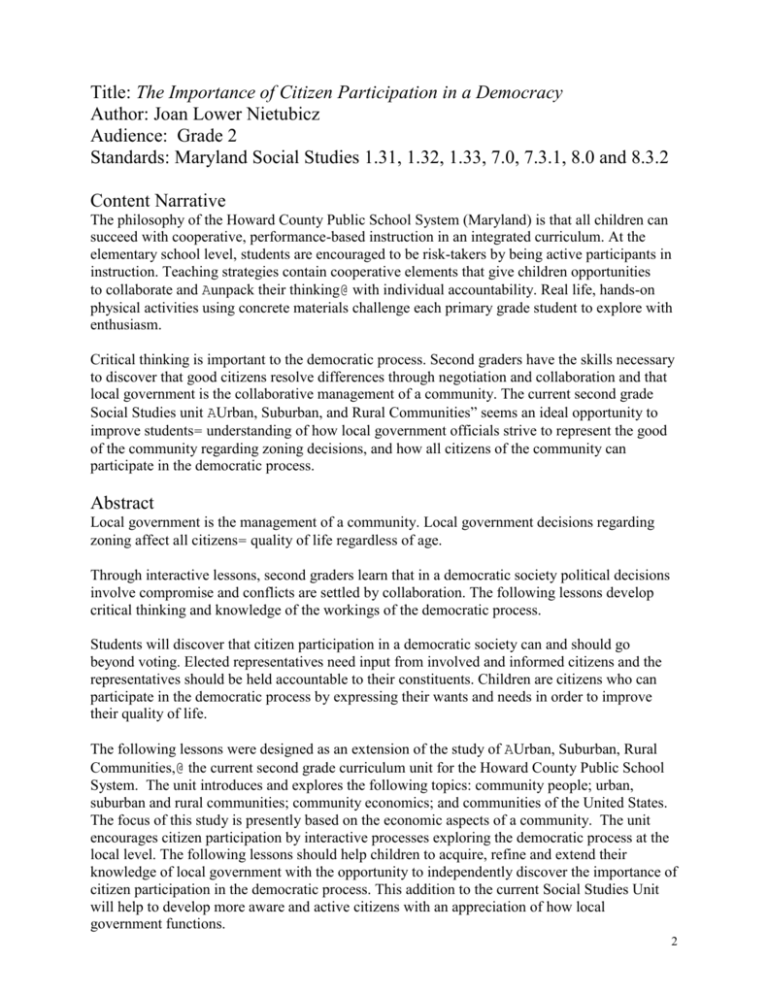
Title: The Importance of Citizen Participation in a Democracy Author: Joan Lower Nietubicz Audience: Grade 2 Standards: Maryland Social Studies 1.31, 1.32, 1.33, 7.0, 7.3.1, 8.0 and 8.3.2 Content Narrative The philosophy of the Howard County Public School System (Maryland) is that all children can succeed with cooperative, performance-based instruction in an integrated curriculum. At the elementary school level, students are encouraged to be risk-takers by being active participants in instruction. Teaching strategies contain cooperative elements that give children opportunities to collaborate and Aunpack their thinking@ with individual accountability. Real life, hands-on physical activities using concrete materials challenge each primary grade student to explore with enthusiasm. Critical thinking is important to the democratic process. Second graders have the skills necessary to discover that good citizens resolve differences through negotiation and collaboration and that local government is the collaborative management of a community. The current second grade Social Studies unit AUrban, Suburban, and Rural Communities” seems an ideal opportunity to improve students= understanding of how local government officials strive to represent the good of the community regarding zoning decisions, and how all citizens of the community can participate in the democratic process. Abstract Local government is the management of a community. Local government decisions regarding zoning affect all citizens= quality of life regardless of age. Through interactive lessons, second graders learn that in a democratic society political decisions involve compromise and conflicts are settled by collaboration. The following lessons develop critical thinking and knowledge of the workings of the democratic process. Students will discover that citizen participation in a democratic society can and should go beyond voting. Elected representatives need input from involved and informed citizens and the representatives should be held accountable to their constituents. Children are citizens who can participate in the democratic process by expressing their wants and needs in order to improve their quality of life. The following lessons were designed as an extension of the study of AUrban, Suburban, Rural Communities,@ the current second grade curriculum unit for the Howard County Public School System. The unit introduces and explores the following topics: community people; urban, suburban and rural communities; community economics; and communities of the United States. The focus of this study is presently based on the economic aspects of a community. The unit encourages citizen participation by interactive processes exploring the democratic process at the local level. The following lessons should help children to acquire, refine and extend their knowledge of local government with the opportunity to independently discover the importance of citizen participation in the democratic process. This addition to the current Social Studies Unit will help to develop more aware and active citizens with an appreciation of how local government functions. 2 Goals To convey to students the importance of citizen participation in the democratic process; to improve students= understanding of how the democratic system works at the local level of government; and to improve the attitudes of young people regarding government. Timing These lessons should be integrated as a piece of the Language Arts/Social Studies block (daily period of two hours and forty-five minutes). Assessment I. Cooperative Learning $ Problem Solving: evaluating alternative solutions $ Reasoning: linking the familiar with the unfamiliar; exploring and sharing of inquiries $ Metacognition: decision-making $ Conceptualization/Generalization: discovering relationships $ Communication: providing for positive student interaction (infer, predict, elaborate) II. Language Arts Students will be able to communicate their ideas effectively: $ Listening/Speaking: cooperating within a group, interacting face-to-face and making presentations $ Creative Writing Journal/Reflections Friendly Letter Business Letter $ Writing Mechanics Complete Sentences Paragraph Formation Handwriting Spelling III. Social Studies Students will improve their understanding of how local government officials represent all citizens in the community. Students will: Obtain, organize, and evaluate information Recognize there can be validity to different points of view Articulate value judgments Describe issues that affect quality of life Distinguish between personal wants of an individual and the needs of a community Recognize the importance of voting for the candidate who will best represent the community Identify roles that all citizens can play in the democratic process 3 Curricular Connections: Grade 2 Physical Education Research (Howard County telephone book): -Number and variety of sports facilities -Number of parks and tot lots Research (Internet or write Dept. of Recreation and Parks): -Square mileage of County park land -Howard County Youth Program, location of sports fields and the number of children who use these fields Media Science/Health Research using Internet Read Howard County Times articles regarding work of Howard County Council Visit online encyclopedias such as ENCARTA View online County satellite images of school neighborhoods Read local newspapers See Extensions for recommended literature Research -Zoning lines of well and/or septic system connections Investigate waste management Discover/count number and species of birds/animals in school or home environment Take field trip to recycling center Invite guest speakers from the Dept. of Recreation and Parks Social Studies/Language Arts: Learn the importance of citizen participation in a Democracy Math Conduct traffic count outside school/home Determine percentage of trucks/busses/cars -Population comparisons 1990/1995/1999/County -Population comparisons of school 1990/1995/1999 Create Bar Graphs 4 Instructional Goals for Improving Thinking: Grade 2 Creation of Products Conceive ideas/predict outcomes Conduct research Create ideal community Apply learning: -Friendly letter -Business letter Conceptualization Develop reasoning for land-use planning Discover relationships among wants/needs of a community regarding land-use planning Decision Making Draw conclusions Defend conclusions Social Studies/Language Arts Learn the importance of citizenship participation in a Democracy Problem Solving Identify problems regarding land-use planning Evaluate solutions regarding zoning decisions Deductive Reasoning Follow general land-use planning problems to the specific Link the unfamiliar to the familiar regarding zoning decisions (the effects on school population) 5 Standards Addressed I. Maryland Social Studies Standards (draft 11/98) Students will demonstrate an understanding of the nature and purposes of various forms of government...by the end of the grade 3, students know and are able to: 1.31 1.32 1.33 7.0 7.3.1 8.0 8.3.2 Describe how people create rules to maintain order and protect themselves Describe how government protects people's lives in our communities Explain why government provides services to people Demonstrate an understanding of how the political system of the U.S. operates and provides opportunities for participation Identify the purpose and process of voting Demonstrate an understanding of citizenship and their rights and responsibilities as citizens Explain the importance of individual and group participation in school and community improvement I I. Maryland School Performance Assessment Program (M.S.P.A.P.) 1992 Social Studies List of Outcomes and Indicators (grades K-3): $ Describe ways in which individuals and groups bring about civic improvement. $ Summarize the main points of a current event. $ Distinguish between the concepts of majority rule and the rights of the individual. I I I. Howard County Public School System Curriculum Guide Performance Indicators: Social Studies: Students will demonstrate the ability (individually and as part of a group) to gather information, think critically, and solve problems to facilitate responsible decision-making, understand complex ideas, and generate new ideas. Students will: $ Obtain/use relevant information by reading, questioning, listening and observing $ Interact with others in groups to achieve common goals Language Arts: Students will demonstrate a positive attitude and confidence in communicating ideas through listening, speaking, reading, and writing. Students will: Demonstrate active listening Gather new information through discussion, questions, comments, and suggestions Invite and respect questions and suggestions from others Demonstrate the ability to address audience, purpose, and topic through effective written communication (see Reflection prompts) Write to express personal ideas across content areas Relate their own experiences in writing 6 Materials for 26-student class: I. Materials for making 3-D Floor Map; zoning/land-use planning Fifty-two (52) lunch size paper bags cut to a variety of heights (cut bags to stand by themselves/label with color-coded dots) Masking tape Markers and pencils Chart paper or chalk board Construction paper (for easy identification of areas) Green = Rural Tan = Suburban Dark = Urban I I. Materials for Cooperative Learning Twenty-six (26) 3X5 index cards (color-coded with dots for random grouping) Five (5) color-coded tag board stand up signs for groups (group chooses team name to label) Five (5) papers for sequential roundtable (see Appendix 1) Five (5) pencils Five (5) clipboards I I I. Materials to Develop Core Thinking Skills Social Studies journal (see Reflection prompts) "Decision-Making is Fun" charts (see Appendix 4) "Send a Problem" (see Appendix 2) Twenty-six (26) red paper squares and twenty-six (26) green paper squares for "Lineups" (see Appendix) “Thoughtful Application Writing Prompts@ (see Appendix 3) IV. Other Materials Word of the Day Chart (see Appendix 10) Graph paper Book Box [consult Approved Literature Connections List (see Appendix 6)] Twenty-six (26) Concept Attainment Sentence Strips for rural/suburban/urban and magnets Five Council Activity Cards (see page 15) 7 Assessment/Goals Specific Social Studies Intended Outcomes for Grade 2: Students will realize that there is an elected five member County/Town Council that represents citizens in the community Students will understand that one of the important jobs of the County/Town Council is decision-making concerning land-use planning Students will investigate some of the reasoning concerning zoning decisions Students will discover the importance of citizen participation in the zoning decision process Students will examine the importance of voting for candidates who will represent the best interests of the community Students will discover ways to be actively involved in the democratic process 8 Anticipatory Set Large group discussion (teacher directed) Review unit on "Community People" (study of the many important people who make our community work) Review rules (laws) necessary for safe and healthful living Review knowledge of urban, suburban, rural communities State unit objectives (e.g., the five County Council/Town members are representatives elected by adults in the community to make decisions regarding land-use planning). Introduce the term zoning (Zoning decisions affect the quality of life of all citizens in the community and for this reason citizens should participate in the democratic system at the local level of government.) Premise Schoolchildren are familiar with the County/Town Council's job of making laws (e.g., bike helmet law and Ano smoking in mall or restaurants@ law). The students are aware that political decisions can affect them personally (overcrowded schools redistricting to new schools; difficulty in accessing park and school ball fields new user fees for parks and school gymnasiums). 9 DAY 1 Classroom Teaching Activities: Define Urban, Suburban, and Rural Communities Discuss AUrban, Suburban, and Rural Communities@ unit with teacher Review information by brainstorming about what government provides communities for safe and healthful living conditions: government services, health services, stores (goods), recreation facilities, shelters, other services Review map skills (show large, flat map of the community) Divide into five teams using random grouping technique Choose team names in groups Discuss in Sequential Roundtable (see Appendix 1) what paper bag buildings should be built Demonstrate cooperation and collaboration in groups to decide what buildings should be constructed and by whom Make and label buildings Debrief with teacher Review description of the three areas: urban, suburban, and rural Use 26 sentence strips (with magnets) for review of Concept Attainment (e.g., Rural: "Sheep are grazing on the hill.”; Suburban: "The children play baseball on their lawn."; and Urban: "The McCormick factory makes cinnamon.") Decide in teams the best places for buildings to be placed for rural, suburban, and urban land planning Implement Thoughtful Application (see Appendix 3): individual students each place a building on construction paper floor map (pre-prepared by teacher) divided into the three areas (rural, suburban and urban) and defend their decision of placement Review (as a whole class) reasons why your community is rural, suburban or urban Identify (teacher) your County/Town Council members as the elected representatives in the community who make land-use planning decisions Classroom Writing Assignment Journal Reflection -Describe activity -Share what you learned -Apply what the activity taught you -List 2 questions you have about this activity -List 2 ways you can further investigate your ideas Homework Assignment Interview parent or guardian on the purpose of voting List three reasons why you would choose one candidate over another to represent you in a class election 10 Day 2 Classroom Teaching Activities Introduce the concept of zoning Review economic factors necessary for a successful community including services, taxes, elements of culture (whole class discussion) Discuss (as a group) the concepts of representation and election Discuss the necessity to choose the best representative (review positive attributes such as honesty, fairness, active listening) and relate discussion to student council Review homework Regroup into original five teams: each team elects one member to represent them on the Rural/Suburban/Urban Council Separate the Council members into a new group Discuss with Council your school=s rural/suburban/urban community needs Give Council members individual Council Activity Cards (see page 15) concerning factors affecting zoning decisions Classroom Writing Assignment Journal Reflection Describe activity Share what you learned Apply what the activity taught you List 2 questions you have about this activity List 2 ways you can further investigate your ideas Homework Assignment Identify and discuss with a parent/guardian the various ways that citizens can participate in their communities List three ways that citizens can participate in their communities 11 Day 3 Classroom Teaching Activities Re-state the objective of the lesson (It is important for citizen participation to go beyond voting. Citizens of a community can participate in a democracy by being informed about issues affecting their quality of life and by making their elected representatives aware of their concerns.) Review the function of the Council (At the local government level, the Council makes the decisions concerning land-use planning/zoning which can affect the students= quality of life. As citizens of the community, students can participate in our democracy by making their concerns known to their parents, their school PTA and principal, the Council, and the Board of Education.) Review the responsibilities of the class-elected Council representatives Note: Because of the media, children seem to be exposed more to national political issues than local issues (unless some local issues receive national attention). However, local issues related to zoning decisions have a direct impact on citizens= quality of life on a daily basis regardless of age. The teacher should lead a discussion of local issues such as the location and funding of: New schools Fire stations/Police stations Traffic lights at intersections Bike paths Public transportation Sidewalks in neighborhoods Parks Libraries Begin Role Play Activity Distribute to each of the five original teams (less elected Council members) a zoning problem on a 3x5 index card Examples: 1. You are the owners of a local miniature golf course. You want to add a go-cart track because you think it will bring more people to your business. You need to present your request before your Council and try to convince the Council members to let you do this. 2. You are homeowners in a residential neighborhood who want to place children=s swing sets and sand boxes on adjacent County park land. You must try to convince the Council why a tot lot would be an asset to the whole community. List reasons (within groups) to convince the Council to solve group zoning problems Present zoning problems before the Council and defend re-zoning requests using Council Activity Cards (see page 15) 12 Day 3 (Continued) Distribute "Decision-Making is Fun" charts (see Appendix 4) Discuss pros and cons regarding re-zoning problem in groups (Council asks questions. All citizens who favor the proposed zoning are given the opportunity to testify before the Council. All citizens who oppose the proposed zoning are given the opportunity to testify before the Council.) Carry out a vote by Council and announce its decision Proceed through all five team=s zoning problems Note: Can be carried further with Send a Problem (see Appendix 2) Review why it is important for citizens to participate in local government zoning issues Explore Internet ideas Recap the importance of Citizen Participation: Elect sensible and dedicated leaders Follow issues through news Attend Council hearings Assume role as activist Assume leadership role in the community (even if not elected to a formal position) Classroom Writing Assignment Writing Prompt (see Appendix 3): Form: Audience: Topic: Purpose: Friendly letter Parent/guardian Importance of citizen participation in local government zoning issues To convince parent or guardian to become more actively involved in local government political issues (e.g., zoning) Homework Assignment Deliver your letter to your parent or guardian. Discuss current zoning issues. Bring to school one article from a newspaper concerning a zoning issue. Note: It is recommended that the teacher make available for loan to the students copies of selected newspaper articles for their review. 13 DAY 4 Classroom Teaching Activities Discuss homework=s focus on current events. Teacher should try to find one current issue before the County/Town Council that affects the school population. Discuss the importance of citizen participation regarding making concerns known. Classroom Writing Assignment Writing Prompt (see Appendix 3): Form: Audience: Topic: Purpose: Business letter School Principal or P.T.A. President Local issue affecting the school population Citizen participation Homework Assignment Write a question to ask an elected official who will visit the class on Day 5. 14 DAY 5 Classroom Teaching Activities Have a guest speaker from the County/Town Council visit the classroom. Note: Utilize community activists and/or technical staff from the Department of Planning and Zoning as additional and/or alternate speakers. Facilitate dialog between speaker and students. Classroom Writing Assignment Writing Prompt (see Appendix 3): Form: Audience: Topic: Purpose: Business letter School Principal or P.T.A. President Local issues affecting the school population Citizen participation Homework Assignment Discuss with a parent or guardian what you found interesting about today=s classroom speaker. List three things this person does as an elected representative that affects your life. 15 Suburban Council Activity Cards You were elected as a Council person to serve and protect the entire County. It is your job to make land-use planning decisions. In order to make a good decision, you need accurate and timely information. You should ask both the citizens requesting the zoning and the citizens opposing the zoning many questions including the following: Why do the property owners/developers want the zoning? Do other citizens want the property rezoned? Would the new use require new water or sewer lines? If the new use will be a business, what will the hours of operation be? What kind of signs will be placed on the property? What will the lighting be like? Will the new use generate trash? Will neighboring properties hear or smell anything due to the new zoning? Will more traffic come into the area? How will neighboring schools and residents be affected? Will the value of neighboring homes be affected? Use your "Decision-Making is Fun" (see Appendix 4) chart to help you make a fair and informed decision. Remember, you need to weigh the rights of the land owners and their neighbors as well as the County=s needs. The decision for what is best for the County is not always the most popular decision. 16 Extension Activities: $ $ $ $ $ $ $ $ $ $ Create Book Box [Approved Literature Connections List (see Appendix 6)] Prepare writing assignment (see Reflection prompts) Implement AQuestion of the Day@ Create AWord of the Day@ [possible choices include: democracy, judgment, elect, negotiate, participate, responsibility, compromise, issue, relevant, effectively, characteristics, evaluate, etc. (see Appendix 10)] Explore Internet (plan visit to School Media Center and access related web sites including the County Government web site, www.co.ho.md.us, online encyclopedias such as ENCARTA, www.encarta.msn.com, county maps including online satellite images of school neighborhood, www.terraserver.microsoft.com). Invite two community activists representing opposing sides of a zoning issue to present their ideas Invite speakers from P.T.A. and/or School Board to discuss school related issues Collect and examine letters to the editor in local and state newspapers and relate to citizen participation Invite individuals involved in the community to speak (Scout leaders, County/Town youth program volunteer sports coaches, etc.) about the importance of volunteerism Take a field trip to the school district transportation office to view computerized school bus route maps 17 The Democracy Project The Importance of Citizen Participation in a Democracy Lesson Plan for Grade Level 2 Joan Lower Nietubicz Howard County, Maryland August 18, 1999 Sponsored by the Institute for Public Administration College of Human Services, Education & Public Policy University of Delaware In Cooperation with the Office of the Secretary of State First State Constitutional Scholarship Foundation With Special Funding and Support from the Delaware River & Bay Authority Delaware Heritage Commission 18 Appendix 1 - Sequential Roundtable Preparing Students for Academic and Social Skills Tell students that they will be working together to get many ideas on one sheet of paper. Practice passing an object in Asequential order@; a good term for students to add to their vocabularies! Discuss how to give clues without telling answers. Step 1: Put students in groups of 3 to 4. Give each group 1 piece of paper and 1 pencil. Ask a question with multiple, but brief responses. Some possibilities are: 2 numbers that, when added, equal 12 Names of animals Names of fruits and vegetables Modes of transportation Fairytale characters Community helpers Ways to get from home to school Students may also Abuild@ a sentence or mathematics problem Step 2: When the signal to begin is given, the first member quickly writes or draws a response and quickly passes the paper to the next person. Students continue to add responses until time is called. Step 3: When time is called, team members read over their paper, then exchange with another team to see what ideas they had. When papers are returned to the original team, congratulations are given, along with recognition of any answers that were unique to that team. Tips for Success: Use a visual in addition to modeling with 3 to 4 students how to pass in sequential order. Let class groups practice passing an object in sequential order. Use the term Asequential order.@ Let groups discuss and share strategies for passing the paper quickly and for having answers ready (sitting close together, removing articles from desk, watching what others draw or write, etc.) Remind students that it is important to use 6" voices when giving clues to prevent other teams from hearing their answers. This also keeps voices at a working level! Be certain that the responses will take only a very short time to write or draw. One student may record all responses for the team if recording will create a problem for some students. Barbara Allen-Cooperative Learning in the Primary Grades, Adapted from Specer Kagan=s Cooperative Learning for Teachers. Howard County Maryland Public School System. 19 Appendix 2 - Send a Problem Preparing Students for Academic Skills Tell students that they will be working as a team to solve several problems. They will need to remember the social skills of taking turns and coming to a consensus. They will also need two teammates to fill the roles of reader and recorder. For very young children who are often using Ainvented spelling@ there will need to be a Agofor@ who will go outside the teams for interpretation of a written message! Step 1 Give each team a Asecret problem@ which is placed on the outside of an envelope or folder. The problems should be related; i.e. AWhat is the most important safety rule to remember when swimming.@ AWhat is the most important safety rule to remember when riding a bike.@ (etc.) Teams may also make up the problem to send. Math story problems work well, as do questions concerning a topic just studied. For very young students, teachers often use the same problem for all teams (AIn the story we read, Ben had no friends. What can he do to get some friends?) Teams may make up their own problem, put their solution in the envelope and pass to the next team. Suggestions for use: Math story problem Classroom problem Questions dealing with social studies, science, etc. Solutions to problems encountered in literature Captions for pictures Hypotheses for science experiments Step 2 Each team discusses possible solutions to the problem, comes to consensus on one, and writes their answer on a piece of paper. The paper is placed in the envelope or folder with is passed to the next team. Team members then read their new problem and respond without looking at previous answers which have been placed in the envelope or folder. Early primary students may respond to the same question by reading the answer of the previous team and responding with a new answer on the same paper. If there is a problem reading Ainvented spelling@ a Agofor@ may go to another team for interpretation. Step 3 When teams have had the opportunity to respond to several questions, the last team reads all the responses and chooses one or two to share with the class. Answers are charted on the chalkboard or on chart paper for discussion. Barbara Allen-Cooperative Learning in the Primary Grades, Adapted from Specer Kagan=s Cooperative Learning for Teachers. Howard County Maryland Public School System. 20 Appendix 3 - Thoughtful Application Writing Prompt Objective: Content to be Assessed: Thinking Process: (decision making, investigation, experimental inquiry, problem solving, invention, comparing, classifying, inducing, deducing, analyzing errors, constructing support, abstracting, analyzing perspectives): Prompt Guidelines: Part I Form Audience Topic Purpose Part II - Gives some type of pre-writing direction and is specific as to what information should be included in the product Part III - Restates the task with the purpose and audience. The last direction should say, ASince _______________ will be reading your ____________________________, be sure to check your capitalization, punctuation, spelling and usage.@ 21 Howard County Maryland Public School System Appendix 4 - Decision-Making is Fun! Problem:______________________________________________ ______________________________________________________ ______________________________________________________ ______________________________________________________ ______________________________________________________ ______________________________________________________ ______________________________________________________ Solution 1 Goal:____________________________ ________________________________ ________________________________ ________________________________ ________________________________ ________________________________ ________________________________ Solution 2 Good Points: Good Points: Bad Points: Bad Points: Decision: Rationale: 22 Howard County Maryland Public School System Appendix 5 - Making Decisions Problem: Possible Solutions: 1. Positives: Negatives: 2. Positives: Negatives: 3. Positives: Negatives: The best way to solve this problem is to: Because: 23 Howard County Maryland Public School System Appendix 6 - Literature Connections – Grade 2 Urban, Suburban, and Rural Communities: Apartment 3 Busybody Nora City Mouse-Country Mouse Cross Country Cat Family Farm The Giant Jim Sandwich Heartland I Go With My Family to Grandma’s Katy and the Big Snow Madeline in London Make Way for Ducklings The Little House Economics: Alexander Who Used to be Rich Last Sunday A Chair for My Mother A New Coat for Anna General Store The Goat in the Rug Little Nino’s Pizzeria On Market Street Music, Music for Everyone The Popcorn Book Snaggle Doodles Tight Times The Town That Moved Appendix 6 - Literature Connections – Grade 2 Deciduous Forests Tundra The Bremmen Town Musicians The First Forest Hansel and Gretel How the Forest Grew North Country Night Once There Was a Tree One Morning in Maine Who Lives Here? Wonders of the Forest Antarctica Nessa’s Fish Penguin Year Northern Alphabet: A is for Arctic 24 Howard County Maryland Public School System Appendix 7 – Line-ups Setting the Academic Goal and Planning for Social Skills Tell students that they will be helping each other line-up in a special order. Students will need to check themselves as well as the position of the students on either side to see if all are in the correct spot. A line-up can be done silently! Discuss ways of communicating other than verbally, i.e. using signals, pointing to cards that students may be holding, holding up fingers, or nodding and shaking heads. Teams or the entire class may be part of a line-up. Suggestions for line-ups: Alphabetical order (each student holds a card on which is printed a letter of the alphabet) By birth month and date, or by birth month Alphabetical order according to first and last name Sequential order (each student will need 1 from a set of pictures or sentences) The number of times you have been to the zoo (anticipatory set for a unit of study, story, etc.) The number of books read over a vacation Extensions Line-ups may be extended by discussing the results and making bar graphs (have students stand behind each other if their responses are the same), by studies of less than and greater than, by “stepping out” (have all vowels or consonants step out, all students born in the fall, etc.) Options on a book [how much was enjoyed, how funny it was, how brave a character was, if you would like to be that character, etc. (see Split, Step, Slide below)] Specific questions about a story or character (should Jack have climbed the beanstalk) Split, Step and Slide (Value Line) Line-ups become Value Lines when an opinion question is asked. The line is SPLIT (count off half of the line), then the second half of the line takes one STEP forward (1 below). Next, the second half of the line turns to the right and walks or SLIDES to the front of the line and stands face to face with the student in their corresponding place (see 2 and 3 below). You then have partners with different viewpoints ready for a discussion. 1 2 3 4 5 6 7 8 9 10 11 12 13 14 15 16 17 18 19 20 21 22 1 Yes Maybe 2 3 1 2 3 4 5 6 7 8 9 No 10 11 25 12 13 14 15 16 17 18 19 20 21 22 Appendix 7 (Continued) Tips for success When teaching students how to Line-up, use visuals as you model with several students. Place a strip of masking tape as a guideline on the floor. Put “placement indicators” on the floor or walls, such as JANUARY at one end, JUNE in middle, and DECEMBER at the other end. When making a line-up “graph”, give each student a square or rectangular piece of paper. Before leaving the line-up, each student should place the paper on the floor where he/she is standing. You will then have a representation of the “graph” even when students have left the Line-up. When students “step out” of the Line-up, have them face the line so that the remainder of the students may give a thumbs up or thumbs down for agreeing or disagreeing. Students may write their responses on a piece of paper which they take to the line. This prevents a student from being swayed by a friend in the decision making process! For a large class or kindergarten class, try having two Line-ups; one on each side of the room. Have two Line-ups across from each other and let each line check the other. Let students make their own Line-up cards (“Write the first letter, or first two letters of your first/last name on your paper as large as you can.”) 26 Barbara Allen-Cooperative Learning in the Primary Grades, Adapted from Specer Kagan=s Cooperative Learning for Teachers. Howard County Maryland Public School System. “In reality, most American youth see few connections between government’s problem solving role and the concerns they currently face in their daily lives.” 27 The New Millennium Project: Part I – American Youth Attitudes on Politics, Citizenship, Government and Voting (National Association of Secretaries of State, 1999) Appendix 8 – Procedure for Developing Any Concept Attainment Lesson Preparing the Lesson 1. Choose a concept. Determine the essential characteristics of the concept you have chosen. 2. Collect 12-15 examples of your concept. These might be pictures, objects, sentence strips, or drawings. Collect an equal number of related things that are not examples of your concept. 3. Look through your positive examples and select the one that best exemplifies your concept. This will be the first example given—you should not attempt to trick your students. Continue to rank your examples from those that are most clear to those that are “gray.” (You may not want any “gray” examples at all when students are first learning this technique.) Follow the same procedure in ranking your negative examples from most clear to least clear. 4. Look at your examples to determine if they contain any characteristics that are unnecessarily distracting. For instance, if you have written on sentence strips, the color of your magic marker or the background paper and the length of the sentence might be unnecessarily distracting. Identify other characteristics that are important for students to focus on. When you begin your lesson, you will give general directions regarding which characteristics are important to focus on and which are not. You will not be specific enough to give away the concept. 5. Line your examples up side by side. Make sure that in selecting your negative examples you have eliminated all of the characteristics contained in the positive examples that are not essential in defining your concept. Try your lesson quickly on a peer volunteer if you can. Teaching the Concept NOTE: The teaching analysis guide contained in this packet presents these steps succinctly. 6. Explain what you are going to do. You have an idea (a concept) that you want the students to figure out. You are going to use a special technique called Concept Attainment that will help them to guess/learn the concept. Students are to keep their guesses private until invited to share. 7. Explain the “yes” and “no” categories. As examples are presented, they will be labeled “yes” or “no.” The “yes” examples have one or more characteristics in common which are all of the essential characteristics of the concept. The “no” examples may not have anything in 28 common other than the fact that they do not illustrate the concept. (Sometimes the “no” examples do share characteristics.) 8. Focus the students’ thinking on appropriate characteristics. (See the notes in step #4.) Appendix 8 (Continued) 9. Tell students that you will begin with your best “yes.” Display the example, give time to study it, and leave it on display. Proceed with your best “no.” 10. Ask students to compare the “yes” examples and contrast with the “no” examples. Ask the students to try to form hypotheses about your concept. Remind students not to call out their guesses. (For upper grades or complex concepts, you might have students write their guesses at intervals. These notes will be useful later when their thinking is “unpacked.”) 11. Check for working hypotheses from time to time with a show of hands or some other signal. After at least 5-8 “yes” and “no” examples, you might select an unlabeled example and ask by a show of hands how many students think it is a “yes” and how many a “no.” You should proceed to confirm or deny their guesses. This feedback will allow you to pace your presentation. 12. Wait until all or nearly all students are sure that they have the concept. Then ask one or more students to try to name the concept and/or its essential characteristics. The volunteers should test their guesses against additional examples. You should state whether they are correct in labeling the examples. 13. When students have correctly named the concept and/or stated its essential characteristics to the best of their ability, you should verify that they are correct. 14. Any additional examples should be labeled “yes” or “no” by the students. Students should justify their answers using the essential characteristics of the concept. 15. Students should, where appropriate, be asked to generate their own examples of the concept and to justify their examples. (This can be extended to a homework assignment, but only if appropriate.) Unpacking the Thinking 16. Now the fun begins by “unpacking” the students’ thinking. Do not drop this important part of the lesson, as it trains students to examine their thinking and helps them to become sensitive to the thinking patterns of others. To help students unpack their thinking, ask questions such as the following: a. What thoughts did you have when I put up the first “yes”? 29 What thoughts did you have when I put up the first “no”? Which example(s) made you modify or throw away an idea that you had? Did any example temporarily throw you off completely? How many of you worked with just one idea at a time? (These are the focused gamblers.) f. How many of you had more than one idea going at first, and then gradually worked down to one idea? (These are the simultaneous scanners.) b. c. d. e. Appendix 8 (Continued) 17. Ask questions that help students evaluate the effectiveness of their thought processes. Which students guessed the concept fastest this time, the focused gamblers or the simultaneous scanners? Do students tend to use the same strategy every time, or do they change roles? Why? 30 Adapted from Bruce Joyce Models of Teaching (from Barbara Allen: Howard Co. MD Public School System) Appendix 9 – Concept Attainment Planning Sheet Audience (subject, grade level): Language Arts, Secondary Concept: Simile Essential Characteristic(s) of the Concept: A simile states an explicit comparison between two things, actions, ideas, etc. A simile uses like or as to link the two parts of the comparison Focus: On what should the learner focus? The use of description in the passages. What should the learner ignore? The length of the passage; whether the passage is a complete or incomplete sentence; the source of the passage. Note: All of the examples are from the works of Ernest Hemingway. YES Examples The five men were spread out like the points of a five-pointed star. It was like saying good-by to a statue. …he had seen the officer dive forward to where he lay now like a heavy, broken bundle of old clothing marking the farthest point that the assault had reached. …they saw the water buffalo coming out of the bush sideways, fast as a crab and the bull coming, nose out, mouth tight closed… You will have to take death as an aspirin. I sat up straight and as I did something inside my head moved like the weights of a doll’s eye and it hit me inside the back of my eyeballs. …but when he thought of the planes coming up he felt as naked on that hilltop as though all of his clothing and even his skin had been removed. …hitting the heavy horns, splintering and chipping them like hitting a slate roof… …there was a flash, as when a blast-furnace No Examples The brush was very thick ahead and the ground was dry. It was a gray overcast day with a low ceiling so their planes were not up. …he heard a cracking crash and felt the slam of .30-06 220 grain solid bullet that bit his flank and ripped in sudden hot scalding nausea through his stomach. However, by the time Santiago reaches home only a skeleton is left of the fish, as is has been viciously attacked by sharks. I could see nothing but the dark and the rain falling across the light from the window. I felt myself rush bodily out of myself and out and out and all the time bodily in the wind. There was a great splashing and I saw the starshells go up and burst and float whitely and rockets going up… …he still could feel the great weight, though the pressure of his thumb and finger were almost imperceptible. Someone took hold of me under the arms and 31 door is swung open… There was a cough, a noise like a railway engine starting… somebody else lifted my legs. Adapted from Bruce Joyce Models of Teaching (from Barbara Allen: Howard Co. MD Public School System) Appendix 4 – Decision Making is Fun! Decision Making is Fun! Problem: ______________ ______________________ ______________________ ______________________ Solution 1 ___________________________ ___________________________ ___________________________ ___________________________ ___________________________ ___________________________ ___________________________ ___________________________ Goal: _________________ ______________________ ______________________ ______________________ Solution 2 ___________________________ ___________________________ ___________________________ ___________________________ ___________________________ ___________________________ ___________________________ ___________________________ ________ 32 Decision: ______________________________ Because: ____________________________________ ____________________________________ ____________________________________ Howard County, Maryland Public School System Appendix 4 – Decision Making is Fun! Decision Making is Fun! Problem: ______________ ______________________ ______________________ ______________________ Solution 1 ___________________________ ___________________________ ___________________________ ___________________________ ___________________________ ___________________________ ___________________________ ___________________________ Goal: _________________ ______________________ ______________________ ______________________ Solution 2 ___________________________ ___________________________ ___________________________ ___________________________ ___________________________ ___________________________ ___________________________ ___________________________ ________ 33 Decision: ______________________________ Because: ____________________________________ ____________________________________ ____________________________________ Howard County, Maryland Public School System 34 Appendix 1 (Continued) Sequential Roundtable Alphabet A I Q B J R C K S D L T E M U F N V G O W H P Z Howard County, Maryland Public School System Appendix 10 – Word of the Day Word of the Day! Week of: _______________ Name: __________________ DATE WORD PRONUNCIATION PART OF SPEECH DEFINITION MONDAY TUESDAY WEDNESDAY THURSDAY FRIDAY Howard County, Maryland Public School System We know how to make good decisions! Problem: Appendix 5 – Making Decisions __________________________________________________________________________________________________________ _______________________________________________________________________________________________________________________________ Possible Solutions: 1__________________________ ___________________________ ___________________________ ___________________________ 2__________________________ ___________________________ ___________________________ ___________________________ 3________________________ _________________________ _________________________ _________________________ + + + _ _ - The best way to solve this problem is to: Because: Some questions I have are: I would like to investigate my ideas further by: Howard County, Maryland Public School System Appendix 3 (Continued) – Student Activity Reflection Name: ___________________________________ Date: ______________________________________ Unit: ____________________________________ Activity #: __________________________________ 1. This activity was about ________________________________________________________________________ ___________________________________________________________________________________________ ___________________________________________________________________________________________ 2. In this activity I found out _____________________________________________________________________ ___________________________________________________________________________________________ ___________________________________________________________________________________________ ___________________________________________________________________________________________ 3. I think that _________________________________________________________________________________ (describe something you observed) because ____________________________________________________________________________________ ___________________________________________________________________________________________ 4. Here are some ways I could use what I learned: ____________________________________________________ ___________________________________________________________________________________________ Howard County, Maryland Public School System
